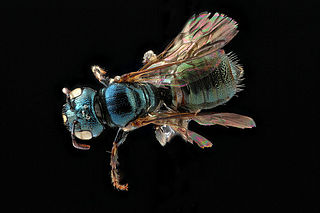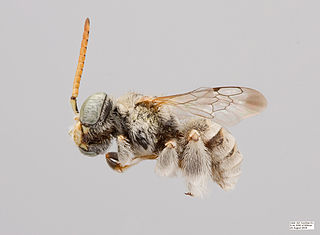
The cosmopolitan bee genus Ceratina, often referred to as small carpenter bees, is the sole lineage of the tribe Ceratinini, and is not closely related to the more familiar carpenter bees. They make nests in dead wood, stems, or pith, and while many are solitary, a number are subsocial, with mothers caring for their larvae, and in a few cases where multiple females are found in a single nest, daughters or sisters may form very small, weakly eusocial colonies. One species is unique for having both social and asocial populations, Ceratina australensis, which exhibits all of the pre-adaptations for successful group living. This species is socially polymorphic with both solitary and social nests collected in sympatry. Social colonies in that species consist of two foundresses, one contributing both foraging and reproductive effort and the second which remains at the nest as a passive guard. Cooperative nesting provides no overt reproductive benefits over solitary nesting in this population, although brood survival tends to be greater in social colonies. Maternal longevity, subsociality and bivoltine nesting phenology in this species favour colony formation, while dispersal habits and offspring longevity may inhibit more frequent social nesting in this and other ceratinines.
Centris cockerelli is a species in the family Apidae, in the order Hymenoptera . The distribution range of Centris cockerelli includes Central America and North America.

Ceratina strenua, the nimble ceratina, is a species of small carpenter bee in the family Apidae. It is found in North America.

Ashmeadiella is a genus of bees in the family Megachilidae. There are more than 60 described species in Ashmeadiella.

Ceratina cobaltina is a species of small carpenter bee in the family Apidae. It is found in Central America.

Neolarra is a genus of cuckoo bees in the family Apidae. There are about 16 described species in Neolarra, all from North America.

Anthophorula is a genus of bees in the family Apidae. There are more than 60 described species in Anthophorula.
Ceratina nanula is a species of small carpenter bee in the family Apidae. It is found in Central America and North America.

Ceratina arizonensis is a species of small carpenter bee in the family Apidae. It is found in Central America and North America.
Herpyllus cockerelli is a species of ground spider in the family Gnaphosidae. It is found in the United States and Mexico.
Ammoplanops is a genus of aphid wasps in the family Crabronidae. There are about 15 described species in Ammoplanops.
Lestiphorus cockerelli is a species of sand wasp in the family Crabronidae. It is found in North America.

Lestiphorus is a genus of sand wasps in the family Crabronidae. There are about 18 described species in Lestiphorus.

Ceratina calcarata, the spurred ceratina, is a species of small carpenter bee in the family Apidae. It is found in eastern North America. This species ranges from Georgia, USA north to Ontario, Canada and east to Nova Scotia, Canada. This bee is a common generalist, native pollinator, it pollinates plants like watermelon and cucumber very effectively. C. calcarata adds to the productivity of a wide range of ecological and agricultural systems due to its wide range and abundance. This small bee is becoming a model organism in the scientific research of social evolution. C. calcarata is the first subsocial bee species to have its genome published, allowing researchers to investigate the evolutionary origins of social behaviour.
Protandrena cockerelli is a species of bee in the family Andrenidae. It is found in North America.
Ceratina sequoiae is a species of small carpenter bee in the family Apidae. It is found in North America.
Ceratina dallatorreana is a species of small carpenter bee in the family Apidae. It is found in Africa, Europe and Northern Asia, and North America.
Pseudaulacaspis cockerelli, known generally as false oleander scale, is a species of armored scale insect in the family Diaspididae. Other common names include the fullaway oleander scale, magnolia white scale, mango scale, oleander scale, and oyster scale. It is found in Europe.

Ceratina acantha is a species of small carpenter bee in the family Apidae. It is found in Central America and North America.

Ceratina dupla, the doubled ceratina, is a species of small carpenter bee in the family Apidae. It is found in the eastern half of North America. It was formerly confused with the species Ceratina floridana and Ceratina mikmaqi, until molecular analyses demonstrated significant genetic differences between the taxa.











